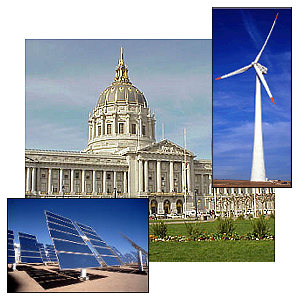
 |
San Fransisco
city official's plans could call for 361 MW of renewable energy for the
city. |
"Energy Independence offers San Franciscans permanent protection
against future energy crises."
- Paul Fenn of Oakland-based Local Power
San Francisco, California - February 20, 2004 [SolarAccess.com]
Joined by consumer groups, environmental groups and international leaders in
renewable energy, San Francisco city officials announced new legislation this
week to use the state's "Community Choice" law, in conjunction with
the City's 2001 Voter-Approved solar "H Bond" Authority, to switch San
Francisco to a new supplier for electricity service and build enough solar
photovoltaic installations, wind turbines, efficiency and conservation
installations, and hydrogen technologies to power 1/4 of the community with
green power before the end of the decade.
The new legislation also creates the opportunity to answer calls from City
neighborhoods to close the polluting Hunter's Point and Portrero power plants.
Supervisor Tom Ammiano announced his "Energy Independence Ordinance"
with co-sponsors - Board President Matt Gonzalez and Supervisor Sophie Maxwell
(representing Hunter's Point) - flanked by Local Power Founder & Director
Paul Fenn (local.org), Sierra Club Int'l Vice President Michele Perrault,
California Wind Credit Law architect Tyrone Cashman, Sacramento Solar Architect
Donald Aitken, UC Berkeley Professor Daniel Kammen, Greenpeace USA and TURN at a
City Hall press conference.
A recent California Public Utilities Commission decision makes room for
communities like San Francisco to break away from utility power contracts to
control their own energy destiny under the 2002 California Community Choice law
(AB117, Migden). The Energy Independence ordinance orders city departments to
prepare an Implementation Plan and Request for Proposals for the Board of
Supervisors to solicit new Electric Service Providers interested in supplying
power to San Franciscans and meeting the City's adopted goal of building 361 MW
of new solar photovoltaic installations, distributed generation such as fuel
cells, wind turbines, hydrogen, energy efficiency and conservation technologies
as standard components of the City's new electricity service.
The conversion, says proponents, would protect residents and businesses against
increasingly volatile fossil fuel prices, close power plants that cause breast
cancer and childhood asthma, and make the City a world leader in the global
effort to stop climate change. On an average day San Francisco requires 650 MW
of power at night and 850 MW during the day, making the 361 MW investment in
green power perhaps the most dramatic urban conversion to green power
technologies ever.
While some components of the new service, such as solar cells, are more
expensive than conventional power sources, the Community Choice law enables
power providers to mix solar with less expensive energy efficiency technologies,
to make the average price of the city's portfolio of resources competitive with
PG&E's electric bills.
"What is more, after it is paid off, this infrastructure will continue to
provider power to San Franciscans at radically lower rates for decades,"
said Paul Fenn of Oakland-based Local Power, who drafted the Energy Independence
ordinance with Ammiano's office, as well as San Francisco's 2001 H Bond
Authority, and California's 2002 Community Choice law. "Energy Independence
offers San Franciscans permanent protection against future energy crises."
The H Bond Authority, which was also sponsored by Supervisor Ammiano for the
successful Proposition H vote in 2001, allows the City to finance the green
power components over ten years, for gradual repayment of the solar, wind,
conservation and efficiency investments so that the more expensive components
need not result in higher rates.
"This will offer a kind of insurance against wildly fluctuating energy
prices and permanently reduce the amount of power San Franciscans need to buy
from the grid," said Ammiano. "We can close the city's polluting power
plants, make the city comply with the Kyoto Treaty and permanently lower rates
for our residents and businesses, all at the same rates PG&E charges - now I
call that a bargain."